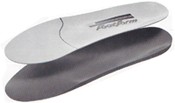Foot Physiology:
- Low Arch foot with Flexible Joints (sometimes referred to as a flat foot)
- High Arch foot with Stiff Joints
- Neutral Arch foot with Moderate Joint Movement
Foot Shape:
- Oblique Toe (Big toe is longer and foot tapers angularly to the small toes).
- Square Toe (Little toes are exceptionally long and big toe is short - The toes are close to the same length).
- Round Toe (Second toe extends longer than the big toe).
Volume: How thick or thin your feet are. Including how much tissue the foot has and how big the bones are of the foot.
- Low volume (Foot could be wide or narrow, but there isn't much bulk to the foot.)
- Mid Volume (Foot is well proportioned.)
- High Volume (Foot is thick, bulky, large boned)
The reason it is important to know that there are nine classifications of feet is to identify the key characteristics of your foot type so that you can focus on comfort footwear or sports performance features that best suit your foot type.
Often a person will choose a shoe based on looks or the advice of a friend, and not really have any idea if the shoe properly fits their foot. As you can see from the list of foot characteristics, there are many variables involved with shoe fitting and depending upon the type of foot you have, you may not easily find the best shoe for your foot without some professional advice.
At Footform Performance Center in Bend, Oregon, we analyze feet, mold and make custom foot orthotics (shoe inserts), then fit the orthotics into the client's footwear. Part of our orthodics service includes shoe consultation and recommendations. Footform custom shoe inserts increase foot comfort and sports performance. I am also available to consult to the shoe industry to create footwear that is designed for the widest variety of foot types.
Call or contact Footform Performance Center, 541-389-4547, 345 SW Century Dr., Bend, OR
Randall@Footform.com








